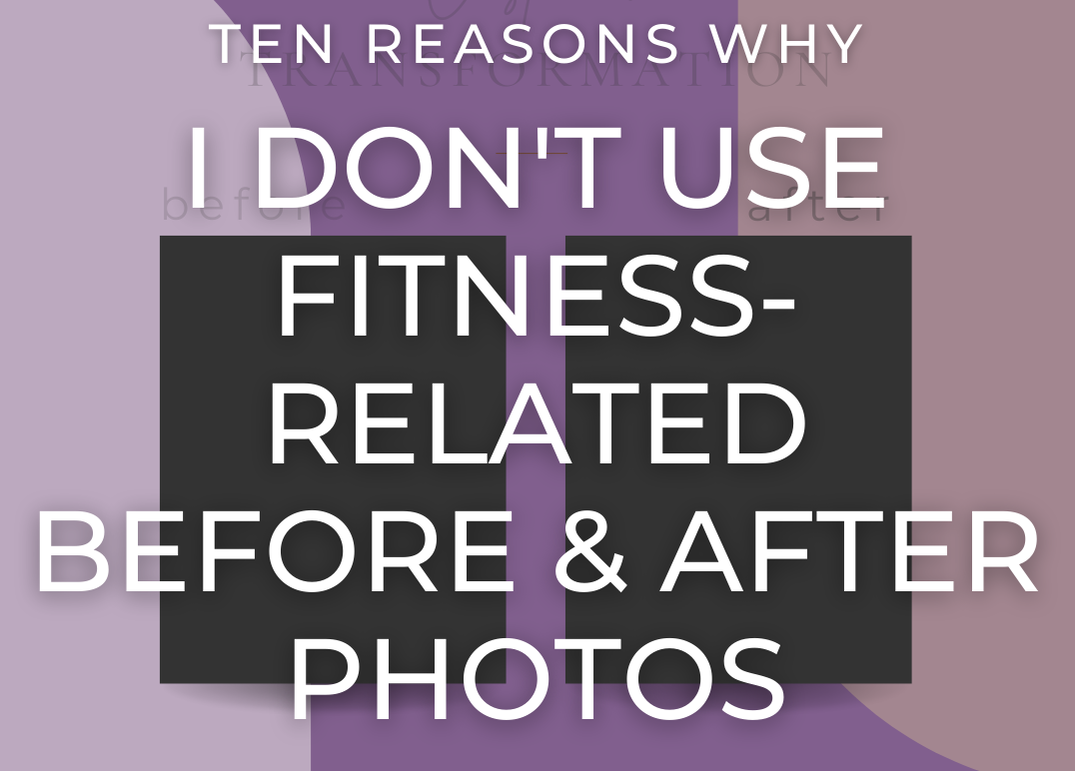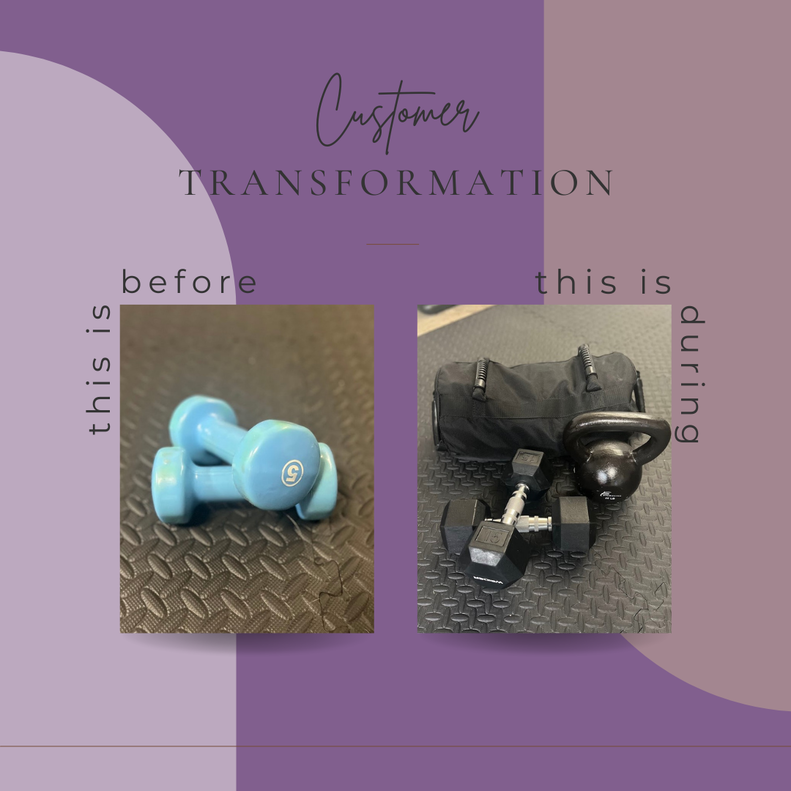|
A few years ago...okay, like 20 years ago, I took “before photos” while on an exercise and diet kick (back before I figured out this consistency thing). I had intentions of exercising my way to a “fit-looking” body. I had it in my head that working out would make me look better (aka closer to the mainstream culture version of an attractive, healthy body). Well, I suppose I never found that reason compelling enough because I quit exercising consistently before getting to that "after photo"-worthy body. Twenty years later, I don’t quite have the "fit body" you often see in after photos. My belly isn’t flat and fat-free. I'm not as lean and muscled as a lot of trainers I see online. But I AM fit (for the life I want to live). I exercise consistently, I’m stronger than I’ve ever been, I eat a nutritious, satisfying, non-restrictive diet. I enjoy it. Exercise has become more about how I feel and less about how I look. We have a problem in the fitness industry that perpetuates the idea that only lean-muscled bodies are fit and the primary motivation for exercising is to look fit (not necessarily be fit). Some are moving away from that ideology or at least some areas of industry are giving it lip- service. I still see A LOT of social media posts emphasizing exercise as a means to shape your body rather than having a healthy body that works well so you can do life. This is why before & after photos can be detrimental. Before you get upset and think, "But training does shape your body!" Of course it can. But for the average middle-aged American who spends 12+hours a day sitting while balance and muscle mass is declining, getting up to move and train purposefully shouldn't be dependent upon desiring a more svelte physique (which is what before & after photos often drive into our heads). Photos can be a tool for some, however, I'll not use them unless a client specifically requests. Here's why: 1. Before and after photos continue to spread the limited perception of what it means to be fit and/or healthy. Smaller size or greater leanness doesn't always equal better health. Visible abs aren't a sign of fitness. It's a sign that the person has a low-body fat percentage (dietary choices/restriction) and likely has done specific abdominal training. 2. They encourage comparison and scrutiny of people’s bodies. Haven’t you had enough of that since like puberty? 3. Before/after photos as inspiration can turn bad. You are not her and she is not you. Your body has been through a much different experience throughout your years on this planet. You have a different living environment and lifestyle. Trying to achieve someone else’s changes can become unhealthy and is often unrealistic. Not only that but training to fix or change specific body parts can lead to muscle imbalances and problems down the road. 4. You often don’t know what the person in the photo had to do to get there – what tradeoffs was she willing to make to achieve this? Was it done healthfully? How does she feel day to day? The photo doesn’t tell you. 5. Before and after photos often imply the person in the before photo is flawed or less than. These photos most often equate being smaller or leaner as “better”. You are not more worthy, loveable, or good just because you weigh less or have more muscle than you did before. 6. These photos can be discouraging to people who would love to be someone’s “before” photo. Occasionally, I have found myself thinking that I look more like someone’s before photo rather than the after. I’m in a really good place when it comes accepting and enjoying my body as it is right now. Previously, it would be a blow to my self-esteem. I would feel shame and question whether or not I should be trying harder to make changes to the way my body looks regardless of how it feels and functions. 7. Photos and videos can be so easily manipulated. It could be really good lighting and poses or filters and photoshop. What you are seeing may not be the truth. 8. Before and after photos can make you believe that your after photo is now your standard. Unless you maintain that after photo appearance or attempt to improve from there, you may never feel good enough. 9. As mentioned before, these photos perpetuate the flawed thinking that training/exercise is mainly for achieving a look. Yes, consistent training can change your body significantly when combined with other lifestyle factors like dietary choices (key), sleep, and stress management. That’s great! However, let's separate fitness for health and well-being from aesthetics. Regular exercise is important even if you don’t want to lose weight. Regular exercise is beneficial even if you are happy with your body as is. Exercise is beneficial even if your body doesn’t really seem to physically change at all! Your bones and muscles are not going to hang around being all strong for you through mid-life and post-menopause unless you are proactive and train to protect them. Focus on training as a way to boost brain, heart, bone and muscle health, improve energy levels, stress relief, better sleep quality, and feeling like a bad ass. 10. Before and after photos do not capture the TRUE benefits of regular training. It's when I hear clients say things like, “I was able to pick up that bag of bird seed and carry it much easier than before.” “I walked farther than I thought I could.” “I couldn’t do this a few months ago.” “My hips feel so much better.” “I sleep better.” “I feel so much better mentally. I needed stress relief.” "I love feeling stronger." These are the true benefits of training and why it’s worthwhile. The changes to your body's appearance are a side effect.
It is okay to want to change your body. It’s okay to feel proud of weight loss or muscle gain. Weight loss or body transformation may be desired for health or an array of reasons. The issue is that we can tie so much of our self-worth to our appearance and how close we are to the current ideal. It's time to normalize the fact that women’s bodies exist in various shapes and sizes. It's up to each of us to determine what makes us feel and function our best. We also need to normalize those of us who “do fitness” with the intention of moving and feeling better without the huge focus on body composition or appearance. If you want to use photos to track changes, go for it. For some, they can be a source of motivation and inspiration. Take precautions though. Pay attention to how you feel, not just your appearance. Don’t put form over function aka appearance over health; it's not worth damaging your health to look a certain way. Use other means to track progress such as energy levels, how well you are sleeping, improved form during exercises, better endurance, progression in lifting more weight, improved balance, better posture, less stress, feeling better overall, etc. Remember, the after photo is a moment. Training consistently results in a more independent, healthier life for years. I'd love to hear your thoughts. I have had some interesting conversations with others on this topic and different perspectives are welcome! _______________________________________________________________________ If you'd like to train with me to improve fitness in mid-life and beyond, contact me for a free initial consult.
0 Comments
Leave a Reply. |
Archives
June 2023
Categories
All
|


 RSS Feed
RSS Feed